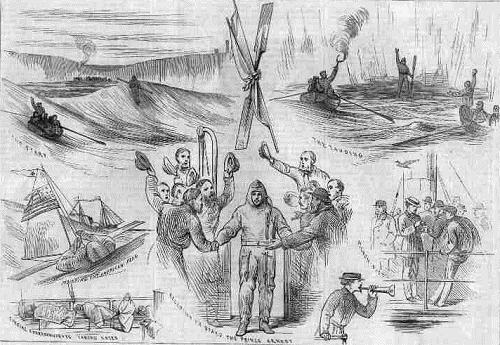Captain Paul Boyton's Channel Crossing

Captain Paul Boyton, from the Illustrated London News, 1875
The Illustrated London News, June 2nd 1875 shows some sketches of "Captain Boyton's successful trip across the Channel" - but was this a swim, a sail or a paddle crossing? [Note: the first true "swim, was a couple of months later by Captain Matthew Webb on 24th August 1875 from the Admiralty Pier at Dover to near Calais in 21 hours 45 minutes]
The inventor Clark S. Merriman, in a bid to help sea-rescue, designed a life preserving suit, which was made from India rubber and was inflatable. This suit was tested by Captain Boyton of the New Jersey Life Saving Service, when he was dropped over the side of a steamer into the Irish sea, in a gale.
The first single-handed crossing of the channel was picked as the next challenge to the suit. On 10th April 1875, Boyton stepped into the water at Dover with only a double-bladed paddle and headed out to sea, followed by reporters in the steam tug 'Rambler'. For the crossing a two square feet canvas was fitted as a sail into the left boot of the suit. On the way Boyton consumed a mixture of beaten eggs, a couple of cherry brandies and a cigar (but no solids). However, the crossing was eventually abandoned when the weather worsened and there were concerns for Boyton's safety; the captain of the chase boat threatened to surrender all charge of his boat at darkness if Boyton failed to come aboard. Boyton did so only when he had made the reporters sign a declaration that the decision to quit was not his. Even so he made a doctor examine him to confirm he was still fit to go on. When he stepped aboard, Boyton had been in the water for 15 hours and had covered 50 miles. The stunt had achieved its aim, he had after all nearly completed the crossing and had proved the seaworthiness of the suit.
Six weeks later, Paul Boyton stepped into the water at Boulogne to attempt another crossing. After waiting for his support crew and the sail which had been left behind, he landed in Dover twenty-three and a half hours later at 2.30 a.m. at Fan Bay near South Foreland. The trip had been uneventful other than a meeting with a porpoise four miles off Dover.
